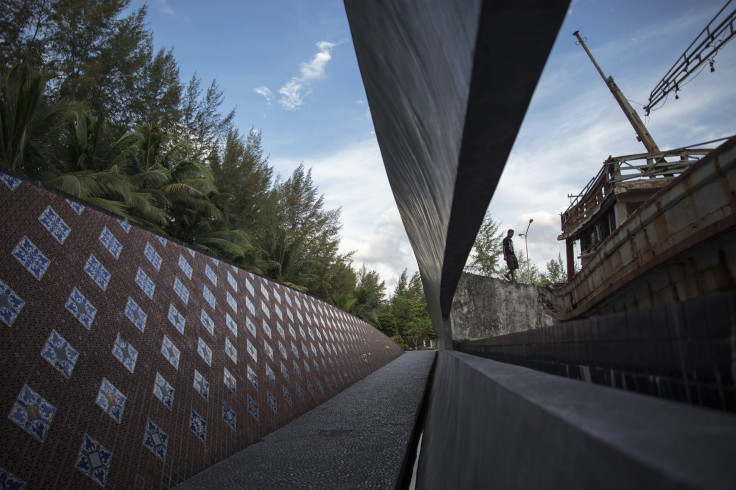Indian Ocean Tsunami Anniversary: Memorials Around The World Honor Victims [PHOTOS]

Communities in the Indian Ocean region have slowly recovered from the wreckage 10 years after a mega earthquake and tsunami struck. It was considered one of the deadliest natural disasters in recorded history, and affected countries received an outpouring of aid. Many monuments and memorials remind of the horror that saw waves over 100 feet high crash into coastal towns, killing over 230,000 people in 14 countries.
A series of earthquake occurred off the west coast of Sumatra, Indonesia, on Dec. 26 2004, when the Indian tectonic plate was forced underneath the Burma plate. The energy released from the quakes was estimated at 26 megatons of TNT – equivalent to 1,500 times that of the 1945 Hiroshima atomic bomb. Earthquakes could be felt as far away as Alaska. Indonesia was the worst-hit country, followed by Sri Lanka, India and Thailand.
Much of the damage came from the tsunami that washed through the coastal communities. There were no tsunami warning systems at the time, and people living along the coast were caught by surprise, despite the several hours of lag between the earthquake and the impact of the tsunami.
Nations from all over the world provided over $14 billion worth of aid, which prevented the spread of diseases common after disasters, such as cholera. Aid was used for food, shelter and repairing infrastructure. Many of these devastated towns have since been restored, and while signs of destruction are gone, some were intentionally left behind to remind those still alive of those who had perished.
Indonesia was the hardest hit of all affected countries, with estimates of 170,000 to 220,000 dead, and another 37,000 missing. A museum was built in Banda Aceh to memorialize the event. It also serves as a tsunami evacuation site.
Khao Lak is a popular beach resort area that was the hardest hit coastal area of Thailand, with 3,950 confirmed deaths out of Thailand's total 4,812 deaths. The Police Boat 813 memorial is a Thai navy boat that washed some 1.3 miles inland from the sea, where it was guarding the Thai king's grandson, Bhumi Jensen. While Jensen's mother, Princess Ubolratana, and his sister survived the tsunami, Jensen did not.

Ban Nam Khem is a fishing village north of Khao Lak, and was also one of Thailand's worst-hit communities. The village was home to a large migrant community. Many stranded fishing ships have been left standing inland, and a wave-shaped tsunami monument was erected as well. Some 2,817 people were reported to be missing following the tsunami.
This memorial in Peraliya, Hikkaduwa, commemorates one of the worst rail disasters with the highest count of deaths in railroad history. More than 1,700 people died when the tsunami crashed into the overcrowded train that was traveling between Colombo and Galle. The carriages were reported to be so packed that the doors could not be opened. Waves washed over the train several times, filling the train with water and drowning almost everyone inside.

A Buddha statue memorial at a vihara, or a buddhist monastery, is located in Peraliya, north of Galle. The statue was built with Japanese assistance after the tsunami, which claimed some 31,229 lives, and 4,093 missing.
The Kanyakumari district is one of India's worst-hit regions, with 900 deaths and many hundreds missing. This monument is located in the southernmost district of Tamil Nadu, which reported around 10,700 casualties. A plaque below the statue reads: "In memory of those who lost their lives in tsunami on 26-12-2004."
While the United Kingdom is not near the disaster zone, 155 British people lost their lives when the tsunami struck while they were vacationing. The monument is installed outside London's Natural History Museum, and the names of the British victims are engraved on the floor.
The monument's steel balls represent the country's 20 atolls, and their upward rise signifies the tsunami's tides. Some 82 people from the country lost their lives, represented by the monument's vertical iron rods each with the victim's name engraved on it.
This monument in Brisbane commemorates 26 Australians who lost their lives or went missing during the tsunami. Tremors could be felt along the north-west coast of Australia during the time of the disaster, and Australians who happened to be traveling abroad to the affected regions lost their lives.
© Copyright IBTimes 2025. All rights reserved.






















